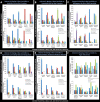Mosquito control practices and perceptions: An analysis of economic stakeholders during the Zika epidemic in Belize, Central America
- PMID: 30024951
- PMCID: PMC6053204
- DOI: 10.1371/journal.pone.0201075
Mosquito control practices and perceptions: An analysis of economic stakeholders during the Zika epidemic in Belize, Central America
Abstract
The tourist-based economy of Belize, a tropical hub for eco-tourism, is at high risk to be disproportionately impacted by established and emerging mosquito-borne diseases such as Zika. An online survey was used to probe economic stakeholders working in the Belize tourism industry about their mosquito control practices and perceptions. Responses demonstrated that the respondents have good working knowledge of mosquitoes and mosquito-borne illnesses. Most businesses surveyed engage in some means of mosquito control, either through larval source reduction or use of insecticides on the premises. Larvicide use was significantly correlated with a general willingness to use insecticides, as well as belief that treatment of water will reduce mosquito densities and disease transmission. A majority of the respondents agreed that they would be interested in buying a new larvicide to be used on the business premises if it were shown to be safe and effective. The safety of mosquito control products for humans, animals, plants, and the environment in general, followed by product effectiveness, are the most critical determinants of mosquito control purchasing decisions. A majority of respondents agreed that control of mosquitoes and mosquito-borne illnesses is central to the success of their tourist-based industry. Respondents expressed significant concern that the Zika epidemic was over-sensationalized by the media, and that this negatively impacted their livelihoods. The respondents, many of whom are associated with eco/sustainable businesses, also voiced concerns that chemical pesticides could have a negative impact on human health and the environment and expressed a desire for balance between effective mosquito control and preservation of the rich biodiversity of Belize. This study provided a framework for further engagement activities in Belize and other Caribbean nations, uncovered both concerns and support for emerging mosquito control technologies, and revealed opportunities for further debate and educational outreach efforts.
Conflict of interest statement
Drs. Duman-Scheel and Eggleson were named as inventors on a pending patent application entitled “RNAi Insecticide Materials and Methods” (International Patent Application No.: 62/361,704). This does not alter our adherence to PLOS ONE policies on sharing data and materials.
Figures






References
-
- PAHO. Dengue fever in the Americas 2017. Available from: http://www.paho.org/data/index.php/en/mnu-topics/indicadores-dengue-en/d....
-
- CDC. Dengue 2018. Available from: https://www.cdc.gov/dengue/.
-
- CDC. Zika virus 2018. Available from: https://www.cdc.gov/zika/about/index.html.
-
- WHO. Zika virus 2018. Available from: http://www.who.int/mediacentre/factsheets/zika/en/.
-
- PAHO. Zika-epidemiological report 2017. Available from: http://www.paho.org/hq/index.php?option = com_docman&task = doc_view&gid = 35105&Itemid = 270&lang = en.
Publication types
MeSH terms
Substances
LinkOut - more resources
Full Text Sources
Other Literature Sources
Medical

